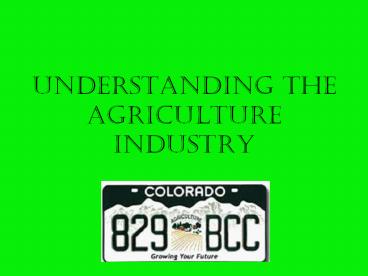Understanding the Agriculture Industry - PowerPoint PPT Presentation
Title:
Understanding the Agriculture Industry
Description:
Title: Unit 9.1, Lesson 1.1 Understanding the Agriculture Industry Author: browns Created Date: 6/12/2006 9:03:17 PM Document presentation format – PowerPoint PPT presentation
Number of Views:170
Avg rating:3.0/5.0
Title: Understanding the Agriculture Industry
1
Understanding the Agriculture Industry
2
Basic Colorado Agricultural Facts
- Colorado has over 30,000 farms, covering 31
million acres, which is ½ of the state of
Colorado! - There are more than 105,000 agricultural jobs in
Colorado, which contribute 16 billion each year! - Colorado has lost over 2 million acres of
production land in the past ten years.
3
Top Agricultural Counties in Colorado
- Weld
- Yuma
- Morgan
- Logan
- Kit Carson
- Prowers
- Otero
- Larimer
- Adams
- Alamosa
Is your county in the top ten? If not, which
county is closest to you?
4
Colorado and the Livestock Industry
- Livestock accounts for 60 of the total
agricultural cash receipts. - Cattle and calves produce 2.6 billion each year,
and account for 2.5 million head! - Colorado ranks fifth in the production of sheep,
lamb, and wool.
5
Colorado and the Livestock Industry
- In 2003, hogs brought in 200 million.
- Colorado producers have diversified to raise
llamas, meat goats, domestic elk, emus, alpacas,
and ostriches.
6
Colorado and Field Crop Production
- Colorados production of sunflowers is fourth in
the nation. - Colorados production of sugar beets ranks eighth
in the nation. - Corn, wheat, hay, and potatoes account for 89 of
all crop revenues in Colorado (excluding sugar
beets). - Colorado ranks first in the production of proso
millet. - Colorado is in the top three states of barley
produced.
7
Colorado and Vegetable Crop Production
- Colorados top vegetable crop is onions, which
accounts for 50 of total veggie revenues. - Sweet corn in the second largest veg. crop,
valued at 16 mln. /year. - Colorado is also known for cabbage, potatoes,
lettuce, and carrot production.
8
Colorado and Fruit Crop Production
- Apples are the most common fruit grown in
Colorado. Because they are commonly grown at
high altitudes, they are known for their
outstanding taste. - The four leading crops are apples, peaches,
pears, and tart cherries. - Other fruits that are well-known in Colorado are
watermelons, cantaloupes, grapes, and apricots,
depending on the area.
9
Colorado and Animal Products
- In 2004, 100,000 cows produced 270 million
gallons of milk. - Our chickens produce 1 billion eggs each year.
- Colorado produces 2 million pounds of honey each
year. - Aquaculture is growing in the state, where
producers raise trout, bass, tilapia, and even
alligators!
10
Colorado and the World Market
- Agriculture in Colorado provides nearly 1
billion in exports annually with Mexico, Japan,
Canada, and Korea receiving the largest share of
Colorado products.
11
Consider this scenario
- The average farm operator in Colorado is a 54
year old male with a farm spanning 991 acres and
worth 757,613. An average farmer has farm
machinery and equipment valued at 87,871, raises
crops worth 41,442 annually and sells
livestock, poultry, and their products valued at
117,951. This farmer grossed 159,393 in 2003.
- Continued on next slide
12
Consider this scenario
- In 2003, this farmer paid
- 42,437 for livestock and poultry
- 22,093 for feed
- 4,463 for seed
- 3,570 for fertilizer and lime
- 2,295 for pesticides
- 4,144 for petroleum
- 5,961 for repairs and maintenance
- 3,794 for marketing, storage, and transp.
- Continued on next slide
13
Consider this scenario
- After this farmer deducted his expenses from his
income and added in an average government payment
of 4,009, his net farm income was 13,228 for
2003. - Obviously, farming is not for everyone! In fact,
only 2.2 of all Americans are directly related
with production agriculture. However, over 10
of the U.S. population is involved in
agriculture. Where are these jobs?
14
Other Areas for Careers in Agriculture
- Food Products and Processing Systems
- Plant Systems
- Animal Systems
- Power, Structure and Technical Systems
- Natural Resource Systems
- Environmental Service Systems and
- Agribusiness Systems

